Enhance the effectiveness of your communication and earn trust by erasing these body language snafus.
Behavioral scientists, psychologists and interrogators the world over study body language as a secondary, and sometimes even more revealing, means of communication. The theory is that the body gives away what the mouth refuses to say. Oftentimes, that’s exactly right.
New business and client referrals are anchored in trust, and your body language can ruin those relationships before they have even begun. Be aware of these common mistakes and take control of the way that others perceive you.
#1: Poor Personal Space Awareness
You’ve probably met a “close talker.” There’s even an old Seinfeld episode devoted to the phenomenon. When you invades a client’s personal space, their natural instinct is to back away. Clients – or anyone else, for that matter – become uncomfortable in the presence of a close talker.
Most people stand at a comfortable distance that encourages the conversation to flow. When that boundary is invaded, it sends a threatening vibe. If you find that clients tend take a step back while you’re talking to them, evaluate your personal space awareness and give them room to breathe.
#2: Going Head-to-Head
Sitting directly across from a client is another arrangement that can send a message of confrontation. When your shoulders are squared off in relation to your client, you come across as an adversary, not an advocate. But you can avoid this wrong body language message by simply shifting your seat.
One of the most common office seating arrangements is the “V.” One chair represents the point of the V and two guest chairs are situated across the desk at slight angles from the point. It’s a non-confrontational configuration that feels collaborative and fosters trust. If there’s only one guest chair, angle it slightly in relation to yours. Avoid sitting directly across the table in a conference room, too, which sends a “squaring off for battle” message.
#3: Glued to Your Cell Phone
When you’re glued to your cell phone, you send a message of weakness. That’s not just because constantly checking your phone is bad manners. It’s also because of the posture that the average person uses while looking at the screen.
Executive presence is one of those soft skills that they just don’t teach in law school. What your client sees is rounded shoulders, a lowered head and a closed-off stance. The body language might have nothing to do with your level of confidence and competence, but your client gets the impression that you’re not as self-assured as you should be.
#4: Closed off to the Room
It’s normal to cross your arms once in awhile. But when that’s your usual stance, you may look like a lawyer with something to hide. While psychologists agree that crossed arms are sometimes just a comfortable position, it can also be a protective device that appears to guard you from being discovered or intimidated. Crossed legs have the same effect, just to a lesser degree.
Open up your posture, and you’ll remove a barrier between you and your clients. While you’re at it, avoid making fists, clenching your hands together or any other closed body language.
#5: Holding Your Chin High
Some people look down their nose when talking with anyone, even their clients. Sometimes the problem is more literal than figurative. When you tilt back your head mid-conversation, either standing or seated, your chin naturally goes up. The body language effect is one of condescension, or looking down your nose at the person across from you.
With your chin up, you emote a disrespectful message, which can leave a bad taste in your client’s mouth. Work on seeing eye-to-eye to eliminate the suggestion of arrogance and put your client at ease. Lower your chin and meet eye-to-eye, and they will feel less threatened.
#6: Touching Your Face
This is one of the classic revealing body language signals. People who have a habit of touching their face are often viewed as keeping a secret. When a lawyer does this, the client could see a red flag.
Unfortunately, clients might think you’re duplicitous, even if you’re really just scratching your nose. In addition, when your hand partly blocks your mouth, it’s a subconscious gesture intended to cover up a false statement.
#7: Shifty Eyes
Eye contact is a vital element of effective communication. There’s a reason why shifty-eyed people are usually considered shifty in general. When you avoid eye contact, you send a disingenuous message. Or clients might think that you’re bored.
Aim for making eye contact about half the time when you’re speaking. But, when you’re listening, give clients the assurance and respect of eye contact at least 70 percent of the time.
Body language can be subtle, and other times so overt that the other party is made visibly uncomfortable. As a lawyer who wants to guarder an image of respect and trust, that’s the opposite of what you want to do.
These unspoken messages can undermine credibility, obliterate trust, weaken professional and lawyer/client relationships and generally work in opposition to everything you’re trying to build. But with something as basic as a little awareness, you can take control of how your clients and referral sources see you.


